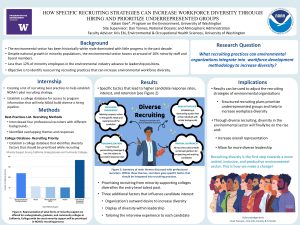HOW SPECIFIC RECRUITING STRATEGIES CAN INCREASE WORKFORCE DIVERSITY THROUGH HIRING AND PRIORITIZE UNDERREPRESENTED GROUPS
Over the past few decades, the environmental sector has seen little progress toward diversifying the workforce. This lack of diversity stems from structurally unfair recruiting strategies that often skim over underrepresented groups. The purpose of this study is to identify how environmental agencies can restructure their recruiting strategies to promote diversity through hiring and prioritize underrepresented demographics. I worked as an intern with the National Oceanic and Atmospheric Administration (NOAA) to compile a list of recruiting best practices and gather data to determine which colleges should be prioritized when recruiting with a focus on marginalized groups. In order to better understand diverse recruiting, I interviewed four professional recruiters in different industries. The results of these interviews had many overlapping themes such as personalizing messages, customizing the interview experience, and creating an inclusive community through diversity initiatives. In addition to interviewing professionals, I created a college database for the NOAA to utilize when hiring students. This database highlights California colleges and universities that are recognized minority-serving institutions or provide minority support through supplemental programs.
This study is significant because the results will help establish structured recruiting plans that prioritize underrepresented groups, increase workplace diversity, and promote a more inclusive work environment. Most environmental organizations are in need of an updated recruiting system that shifts to prioritizing groups that are vastly underrepresented within the industry workforce. In utilizing the specific strategies found through my research, environmental agencies can successfully increase diversity through hiring and address the gap in representation.
